HI6006 Competitive Strategy: Strategic Analysis of Coles
VerifiedAdded on 2022/11/29
|9
|1804
|235
Essay
AI Summary
This essay provides a comprehensive strategic analysis of Coles, an Australian supermarket chain, using four key strategic tools. The analysis begins with the PESTLE framework, examining political, economic, social, technological, legal, and environmental factors impacting Coles. It then applies a SWOT analysis to evaluate the company's strengths, weaknesses, opportunities, and threats. The Porter Five Forces model assesses the competitive landscape, including the threat of new entrants, bargaining power of suppliers and buyers, threat of substitutes, and rivalry among competitors. Finally, the Ansoff Matrix is used to explore potential growth strategies, including product development, market penetration, market development, and diversification. The essay incorporates real-world examples and references to support its analysis, providing a detailed understanding of Coles' strategic position and potential future directions.
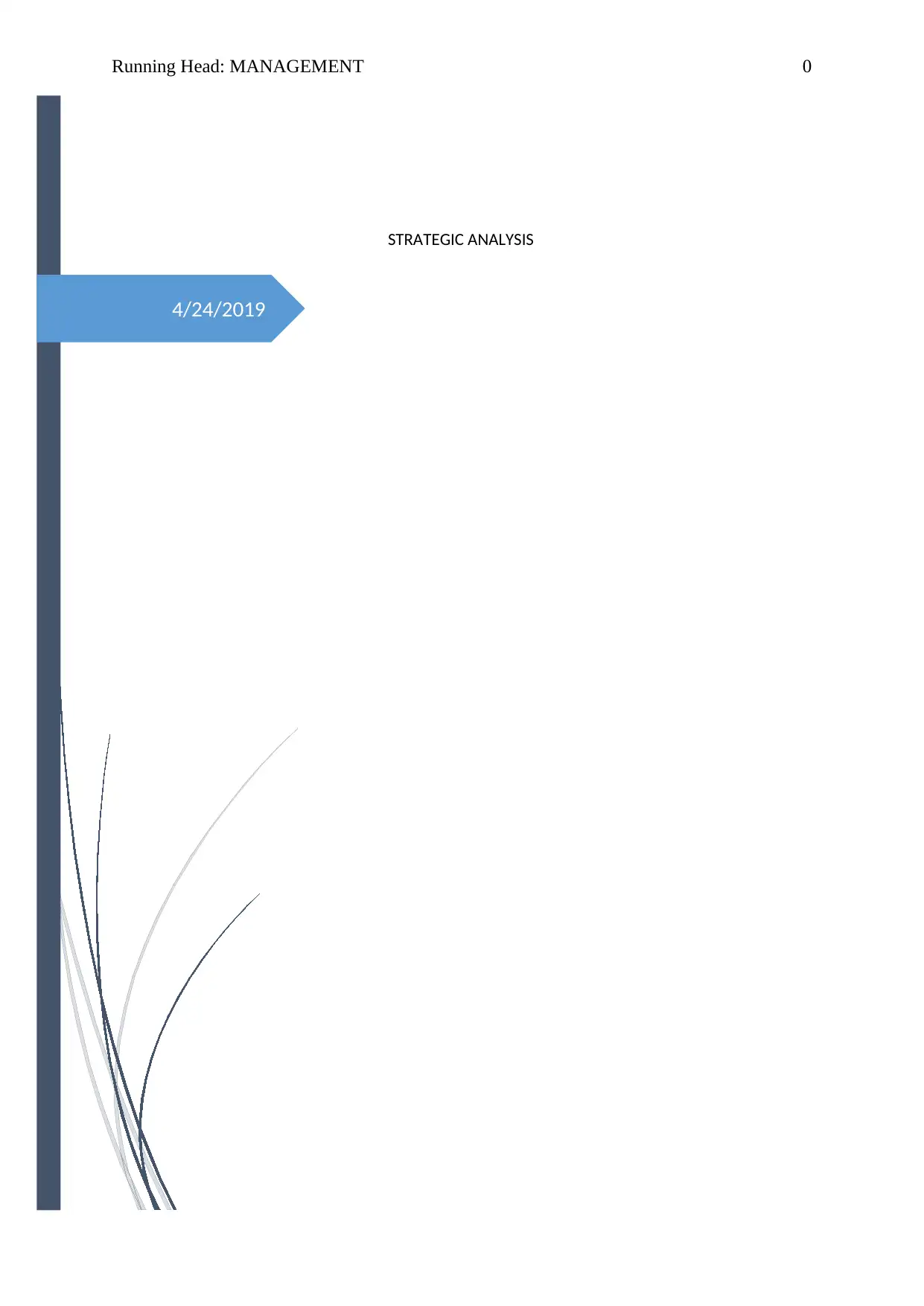
4/24/2019
Running Head: MANAGEMENT 0
STRATEGIC ANALYSIS
Running Head: MANAGEMENT 0
STRATEGIC ANALYSIS
Paraphrase This Document
Need a fresh take? Get an instant paraphrase of this document with our AI Paraphraser
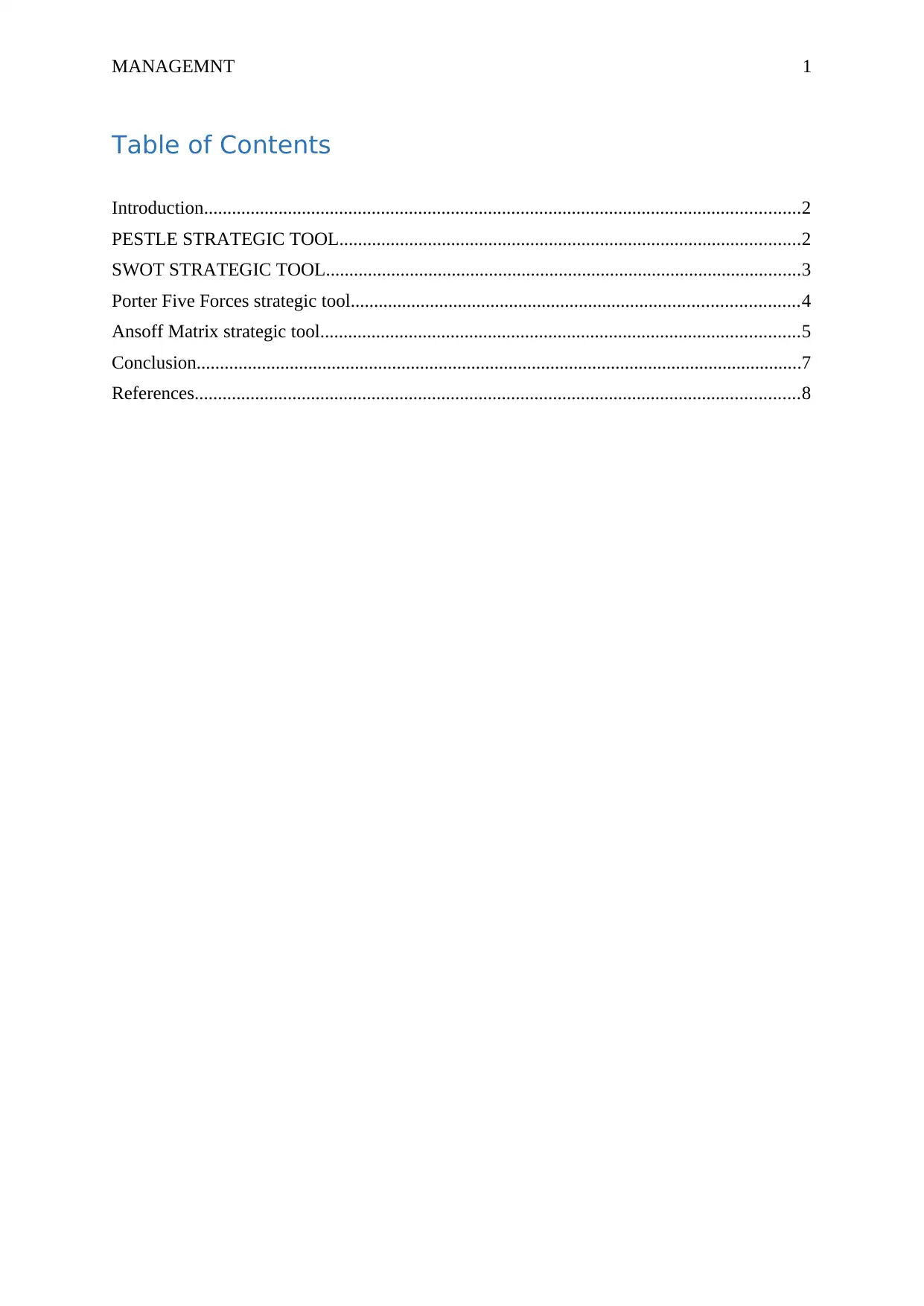
MANAGEMNT 1
Table of Contents
Introduction................................................................................................................................2
PESTLE STRATEGIC TOOL...................................................................................................2
SWOT STRATEGIC TOOL......................................................................................................3
Porter Five Forces strategic tool................................................................................................4
Ansoff Matrix strategic tool.......................................................................................................5
Conclusion..................................................................................................................................7
References..................................................................................................................................8
Table of Contents
Introduction................................................................................................................................2
PESTLE STRATEGIC TOOL...................................................................................................2
SWOT STRATEGIC TOOL......................................................................................................3
Porter Five Forces strategic tool................................................................................................4
Ansoff Matrix strategic tool.......................................................................................................5
Conclusion..................................................................................................................................7
References..................................................................................................................................8
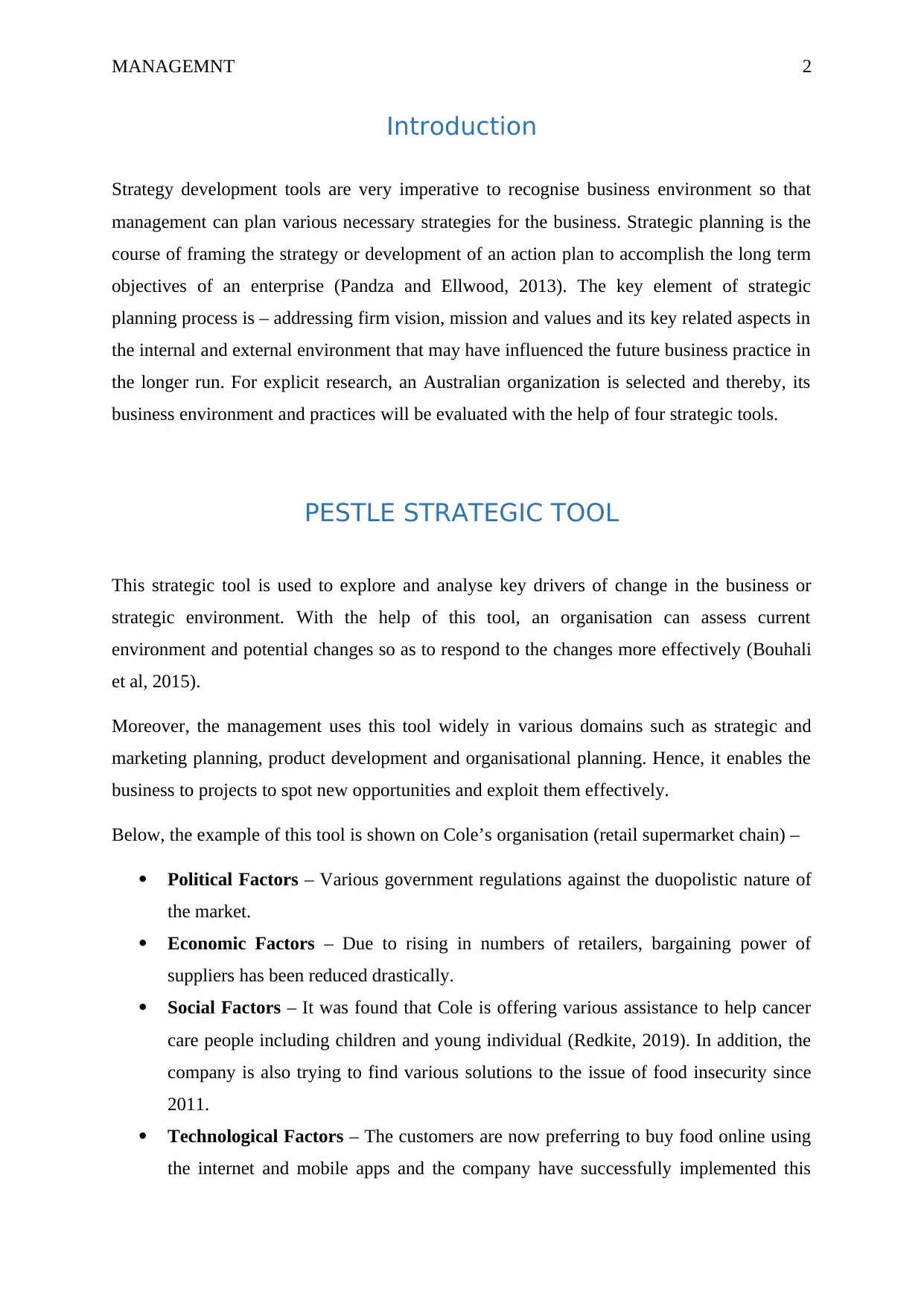
MANAGEMNT 2
Introduction
Strategy development tools are very imperative to recognise business environment so that
management can plan various necessary strategies for the business. Strategic planning is the
course of framing the strategy or development of an action plan to accomplish the long term
objectives of an enterprise (Pandza and Ellwood, 2013). The key element of strategic
planning process is – addressing firm vision, mission and values and its key related aspects in
the internal and external environment that may have influenced the future business practice in
the longer run. For explicit research, an Australian organization is selected and thereby, its
business environment and practices will be evaluated with the help of four strategic tools.
PESTLE STRATEGIC TOOL
This strategic tool is used to explore and analyse key drivers of change in the business or
strategic environment. With the help of this tool, an organisation can assess current
environment and potential changes so as to respond to the changes more effectively (Bouhali
et al, 2015).
Moreover, the management uses this tool widely in various domains such as strategic and
marketing planning, product development and organisational planning. Hence, it enables the
business to projects to spot new opportunities and exploit them effectively.
Below, the example of this tool is shown on Cole’s organisation (retail supermarket chain) –
Political Factors – Various government regulations against the duopolistic nature of
the market.
Economic Factors – Due to rising in numbers of retailers, bargaining power of
suppliers has been reduced drastically.
Social Factors – It was found that Cole is offering various assistance to help cancer
care people including children and young individual (Redkite, 2019). In addition, the
company is also trying to find various solutions to the issue of food insecurity since
2011.
Technological Factors – The customers are now preferring to buy food online using
the internet and mobile apps and the company have successfully implemented this
Introduction
Strategy development tools are very imperative to recognise business environment so that
management can plan various necessary strategies for the business. Strategic planning is the
course of framing the strategy or development of an action plan to accomplish the long term
objectives of an enterprise (Pandza and Ellwood, 2013). The key element of strategic
planning process is – addressing firm vision, mission and values and its key related aspects in
the internal and external environment that may have influenced the future business practice in
the longer run. For explicit research, an Australian organization is selected and thereby, its
business environment and practices will be evaluated with the help of four strategic tools.
PESTLE STRATEGIC TOOL
This strategic tool is used to explore and analyse key drivers of change in the business or
strategic environment. With the help of this tool, an organisation can assess current
environment and potential changes so as to respond to the changes more effectively (Bouhali
et al, 2015).
Moreover, the management uses this tool widely in various domains such as strategic and
marketing planning, product development and organisational planning. Hence, it enables the
business to projects to spot new opportunities and exploit them effectively.
Below, the example of this tool is shown on Cole’s organisation (retail supermarket chain) –
Political Factors – Various government regulations against the duopolistic nature of
the market.
Economic Factors – Due to rising in numbers of retailers, bargaining power of
suppliers has been reduced drastically.
Social Factors – It was found that Cole is offering various assistance to help cancer
care people including children and young individual (Redkite, 2019). In addition, the
company is also trying to find various solutions to the issue of food insecurity since
2011.
Technological Factors – The customers are now preferring to buy food online using
the internet and mobile apps and the company have successfully implemented this
⊘ This is a preview!⊘
Do you want full access?
Subscribe today to unlock all pages.

Trusted by 1+ million students worldwide
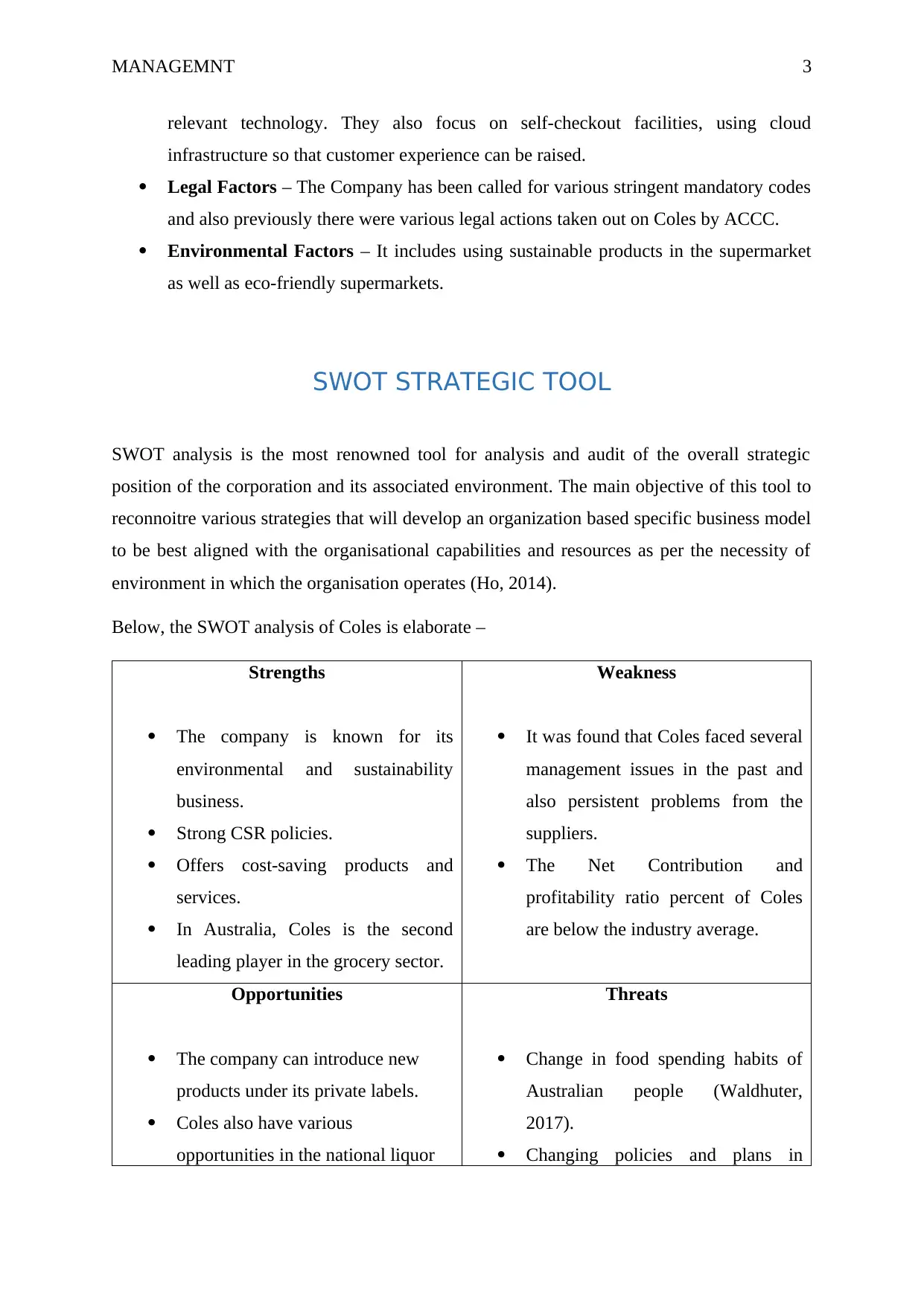
MANAGEMNT 3
relevant technology. They also focus on self-checkout facilities, using cloud
infrastructure so that customer experience can be raised.
Legal Factors – The Company has been called for various stringent mandatory codes
and also previously there were various legal actions taken out on Coles by ACCC.
Environmental Factors – It includes using sustainable products in the supermarket
as well as eco-friendly supermarkets.
SWOT STRATEGIC TOOL
SWOT analysis is the most renowned tool for analysis and audit of the overall strategic
position of the corporation and its associated environment. The main objective of this tool to
reconnoitre various strategies that will develop an organization based specific business model
to be best aligned with the organisational capabilities and resources as per the necessity of
environment in which the organisation operates (Ho, 2014).
Below, the SWOT analysis of Coles is elaborate –
Strengths
The company is known for its
environmental and sustainability
business.
Strong CSR policies.
Offers cost-saving products and
services.
In Australia, Coles is the second
leading player in the grocery sector.
Weakness
It was found that Coles faced several
management issues in the past and
also persistent problems from the
suppliers.
The Net Contribution and
profitability ratio percent of Coles
are below the industry average.
Opportunities
The company can introduce new
products under its private labels.
Coles also have various
opportunities in the national liquor
Threats
Change in food spending habits of
Australian people (Waldhuter,
2017).
Changing policies and plans in
relevant technology. They also focus on self-checkout facilities, using cloud
infrastructure so that customer experience can be raised.
Legal Factors – The Company has been called for various stringent mandatory codes
and also previously there were various legal actions taken out on Coles by ACCC.
Environmental Factors – It includes using sustainable products in the supermarket
as well as eco-friendly supermarkets.
SWOT STRATEGIC TOOL
SWOT analysis is the most renowned tool for analysis and audit of the overall strategic
position of the corporation and its associated environment. The main objective of this tool to
reconnoitre various strategies that will develop an organization based specific business model
to be best aligned with the organisational capabilities and resources as per the necessity of
environment in which the organisation operates (Ho, 2014).
Below, the SWOT analysis of Coles is elaborate –
Strengths
The company is known for its
environmental and sustainability
business.
Strong CSR policies.
Offers cost-saving products and
services.
In Australia, Coles is the second
leading player in the grocery sector.
Weakness
It was found that Coles faced several
management issues in the past and
also persistent problems from the
suppliers.
The Net Contribution and
profitability ratio percent of Coles
are below the industry average.
Opportunities
The company can introduce new
products under its private labels.
Coles also have various
opportunities in the national liquor
Threats
Change in food spending habits of
Australian people (Waldhuter,
2017).
Changing policies and plans in
Paraphrase This Document
Need a fresh take? Get an instant paraphrase of this document with our AI Paraphraser
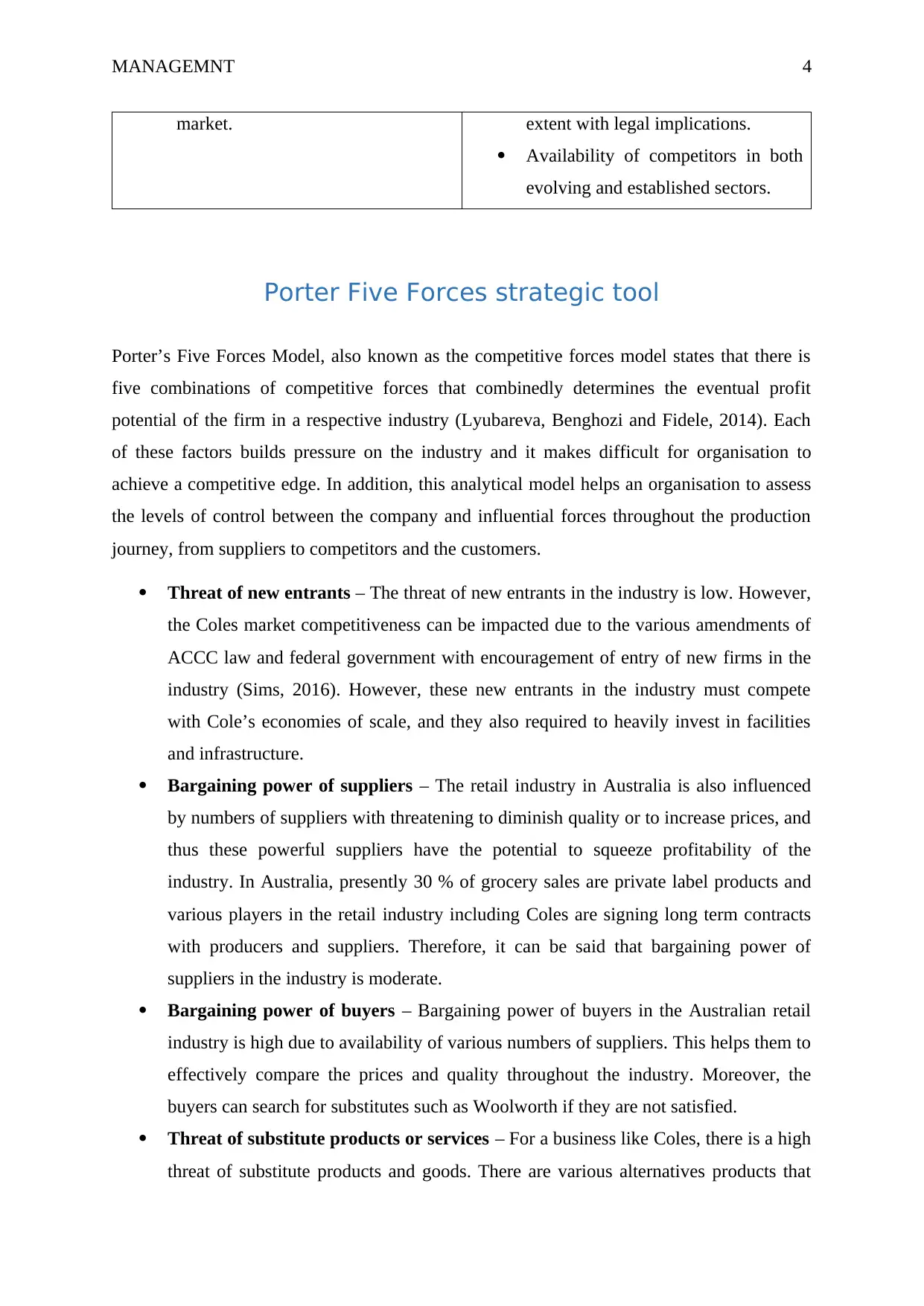
MANAGEMNT 4
market. extent with legal implications.
Availability of competitors in both
evolving and established sectors.
Porter Five Forces strategic tool
Porter’s Five Forces Model, also known as the competitive forces model states that there is
five combinations of competitive forces that combinedly determines the eventual profit
potential of the firm in a respective industry (Lyubareva, Benghozi and Fidele, 2014). Each
of these factors builds pressure on the industry and it makes difficult for organisation to
achieve a competitive edge. In addition, this analytical model helps an organisation to assess
the levels of control between the company and influential forces throughout the production
journey, from suppliers to competitors and the customers.
Threat of new entrants – The threat of new entrants in the industry is low. However,
the Coles market competitiveness can be impacted due to the various amendments of
ACCC law and federal government with encouragement of entry of new firms in the
industry (Sims, 2016). However, these new entrants in the industry must compete
with Cole’s economies of scale, and they also required to heavily invest in facilities
and infrastructure.
Bargaining power of suppliers – The retail industry in Australia is also influenced
by numbers of suppliers with threatening to diminish quality or to increase prices, and
thus these powerful suppliers have the potential to squeeze profitability of the
industry. In Australia, presently 30 % of grocery sales are private label products and
various players in the retail industry including Coles are signing long term contracts
with producers and suppliers. Therefore, it can be said that bargaining power of
suppliers in the industry is moderate.
Bargaining power of buyers – Bargaining power of buyers in the Australian retail
industry is high due to availability of various numbers of suppliers. This helps them to
effectively compare the prices and quality throughout the industry. Moreover, the
buyers can search for substitutes such as Woolworth if they are not satisfied.
Threat of substitute products or services – For a business like Coles, there is a high
threat of substitute products and goods. There are various alternatives products that
market. extent with legal implications.
Availability of competitors in both
evolving and established sectors.
Porter Five Forces strategic tool
Porter’s Five Forces Model, also known as the competitive forces model states that there is
five combinations of competitive forces that combinedly determines the eventual profit
potential of the firm in a respective industry (Lyubareva, Benghozi and Fidele, 2014). Each
of these factors builds pressure on the industry and it makes difficult for organisation to
achieve a competitive edge. In addition, this analytical model helps an organisation to assess
the levels of control between the company and influential forces throughout the production
journey, from suppliers to competitors and the customers.
Threat of new entrants – The threat of new entrants in the industry is low. However,
the Coles market competitiveness can be impacted due to the various amendments of
ACCC law and federal government with encouragement of entry of new firms in the
industry (Sims, 2016). However, these new entrants in the industry must compete
with Cole’s economies of scale, and they also required to heavily invest in facilities
and infrastructure.
Bargaining power of suppliers – The retail industry in Australia is also influenced
by numbers of suppliers with threatening to diminish quality or to increase prices, and
thus these powerful suppliers have the potential to squeeze profitability of the
industry. In Australia, presently 30 % of grocery sales are private label products and
various players in the retail industry including Coles are signing long term contracts
with producers and suppliers. Therefore, it can be said that bargaining power of
suppliers in the industry is moderate.
Bargaining power of buyers – Bargaining power of buyers in the Australian retail
industry is high due to availability of various numbers of suppliers. This helps them to
effectively compare the prices and quality throughout the industry. Moreover, the
buyers can search for substitutes such as Woolworth if they are not satisfied.
Threat of substitute products or services – For a business like Coles, there is a high
threat of substitute products and goods. There are various alternatives products that
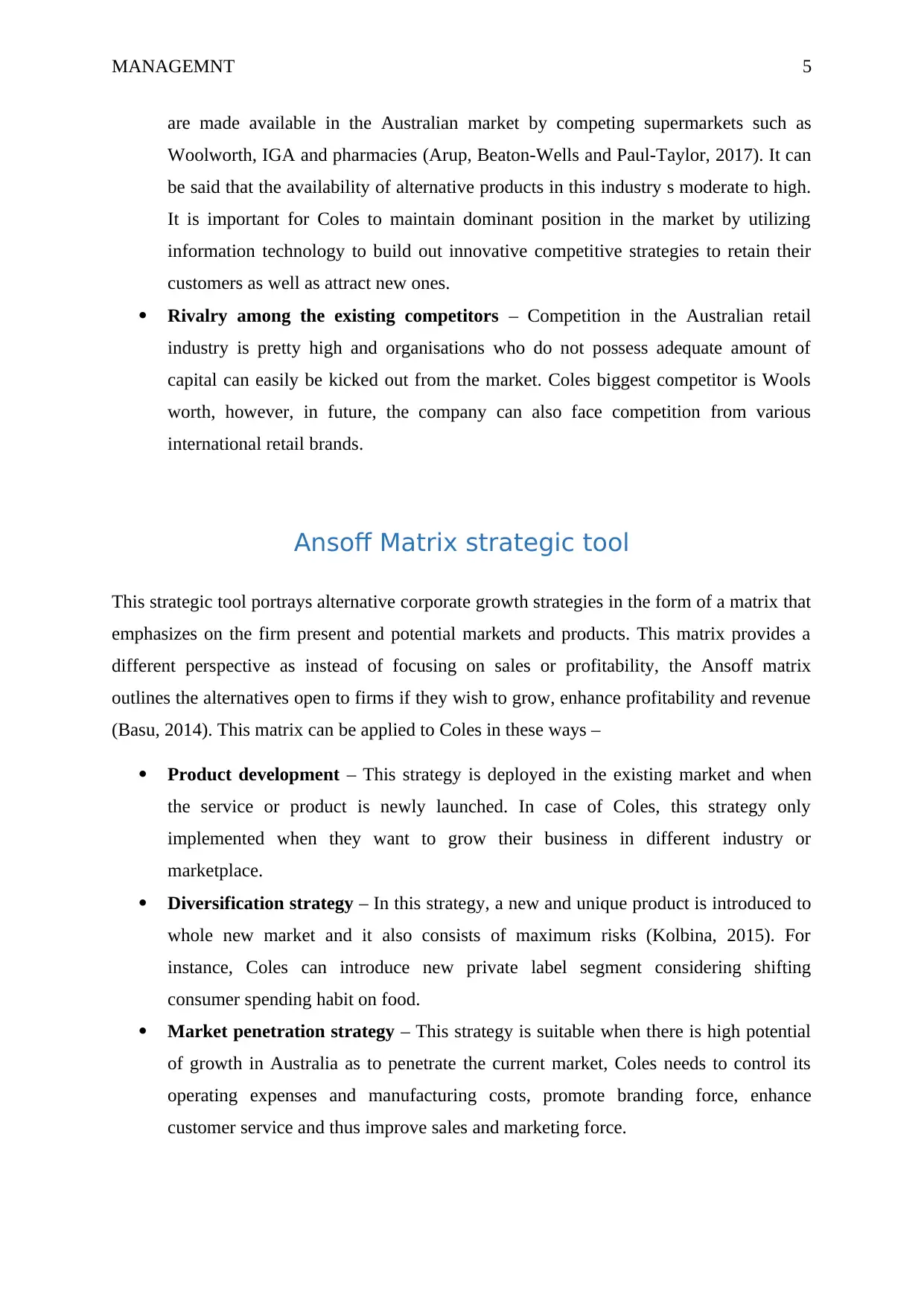
MANAGEMNT 5
are made available in the Australian market by competing supermarkets such as
Woolworth, IGA and pharmacies (Arup, Beaton-Wells and Paul-Taylor, 2017). It can
be said that the availability of alternative products in this industry s moderate to high.
It is important for Coles to maintain dominant position in the market by utilizing
information technology to build out innovative competitive strategies to retain their
customers as well as attract new ones.
Rivalry among the existing competitors – Competition in the Australian retail
industry is pretty high and organisations who do not possess adequate amount of
capital can easily be kicked out from the market. Coles biggest competitor is Wools
worth, however, in future, the company can also face competition from various
international retail brands.
Ansoff Matrix strategic tool
This strategic tool portrays alternative corporate growth strategies in the form of a matrix that
emphasizes on the firm present and potential markets and products. This matrix provides a
different perspective as instead of focusing on sales or profitability, the Ansoff matrix
outlines the alternatives open to firms if they wish to grow, enhance profitability and revenue
(Basu, 2014). This matrix can be applied to Coles in these ways –
Product development – This strategy is deployed in the existing market and when
the service or product is newly launched. In case of Coles, this strategy only
implemented when they want to grow their business in different industry or
marketplace.
Diversification strategy – In this strategy, a new and unique product is introduced to
whole new market and it also consists of maximum risks (Kolbina, 2015). For
instance, Coles can introduce new private label segment considering shifting
consumer spending habit on food.
Market penetration strategy – This strategy is suitable when there is high potential
of growth in Australia as to penetrate the current market, Coles needs to control its
operating expenses and manufacturing costs, promote branding force, enhance
customer service and thus improve sales and marketing force.
are made available in the Australian market by competing supermarkets such as
Woolworth, IGA and pharmacies (Arup, Beaton-Wells and Paul-Taylor, 2017). It can
be said that the availability of alternative products in this industry s moderate to high.
It is important for Coles to maintain dominant position in the market by utilizing
information technology to build out innovative competitive strategies to retain their
customers as well as attract new ones.
Rivalry among the existing competitors – Competition in the Australian retail
industry is pretty high and organisations who do not possess adequate amount of
capital can easily be kicked out from the market. Coles biggest competitor is Wools
worth, however, in future, the company can also face competition from various
international retail brands.
Ansoff Matrix strategic tool
This strategic tool portrays alternative corporate growth strategies in the form of a matrix that
emphasizes on the firm present and potential markets and products. This matrix provides a
different perspective as instead of focusing on sales or profitability, the Ansoff matrix
outlines the alternatives open to firms if they wish to grow, enhance profitability and revenue
(Basu, 2014). This matrix can be applied to Coles in these ways –
Product development – This strategy is deployed in the existing market and when
the service or product is newly launched. In case of Coles, this strategy only
implemented when they want to grow their business in different industry or
marketplace.
Diversification strategy – In this strategy, a new and unique product is introduced to
whole new market and it also consists of maximum risks (Kolbina, 2015). For
instance, Coles can introduce new private label segment considering shifting
consumer spending habit on food.
Market penetration strategy – This strategy is suitable when there is high potential
of growth in Australia as to penetrate the current market, Coles needs to control its
operating expenses and manufacturing costs, promote branding force, enhance
customer service and thus improve sales and marketing force.
⊘ This is a preview!⊘
Do you want full access?
Subscribe today to unlock all pages.

Trusted by 1+ million students worldwide
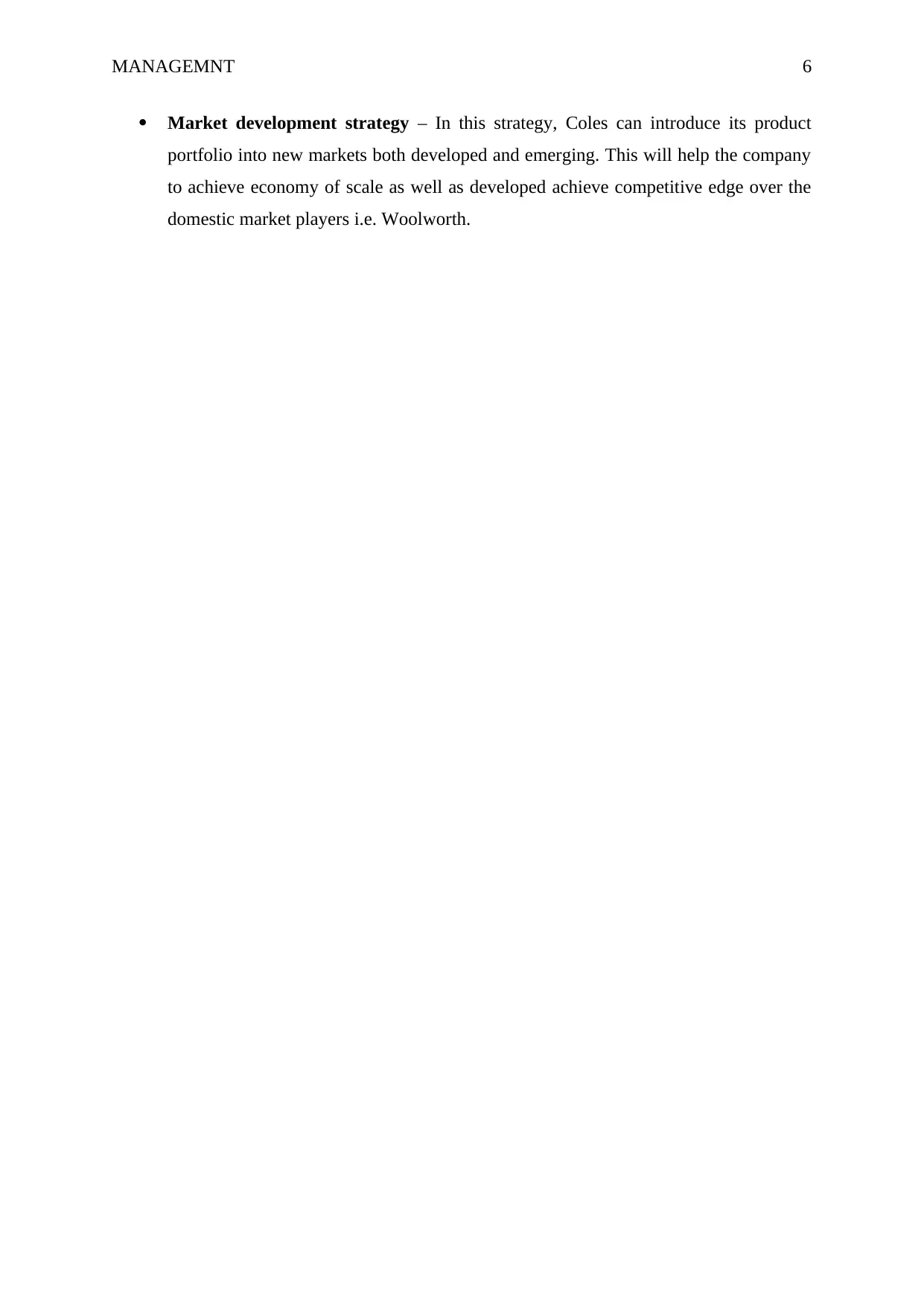
MANAGEMNT 6
Market development strategy – In this strategy, Coles can introduce its product
portfolio into new markets both developed and emerging. This will help the company
to achieve economy of scale as well as developed achieve competitive edge over the
domestic market players i.e. Woolworth.
Market development strategy – In this strategy, Coles can introduce its product
portfolio into new markets both developed and emerging. This will help the company
to achieve economy of scale as well as developed achieve competitive edge over the
domestic market players i.e. Woolworth.
Paraphrase This Document
Need a fresh take? Get an instant paraphrase of this document with our AI Paraphraser
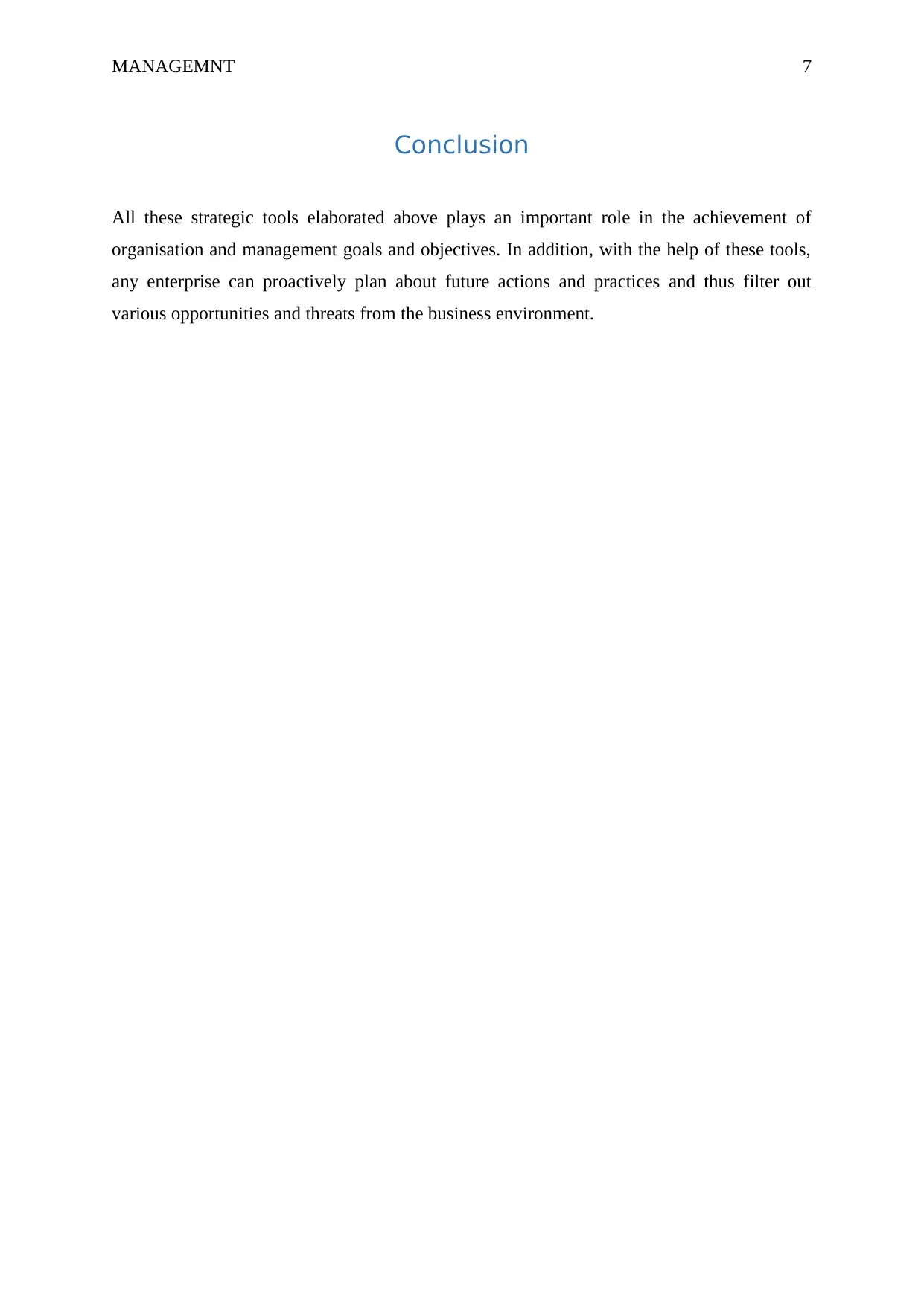
MANAGEMNT 7
Conclusion
All these strategic tools elaborated above plays an important role in the achievement of
organisation and management goals and objectives. In addition, with the help of these tools,
any enterprise can proactively plan about future actions and practices and thus filter out
various opportunities and threats from the business environment.
Conclusion
All these strategic tools elaborated above plays an important role in the achievement of
organisation and management goals and objectives. In addition, with the help of these tools,
any enterprise can proactively plan about future actions and practices and thus filter out
various opportunities and threats from the business environment.
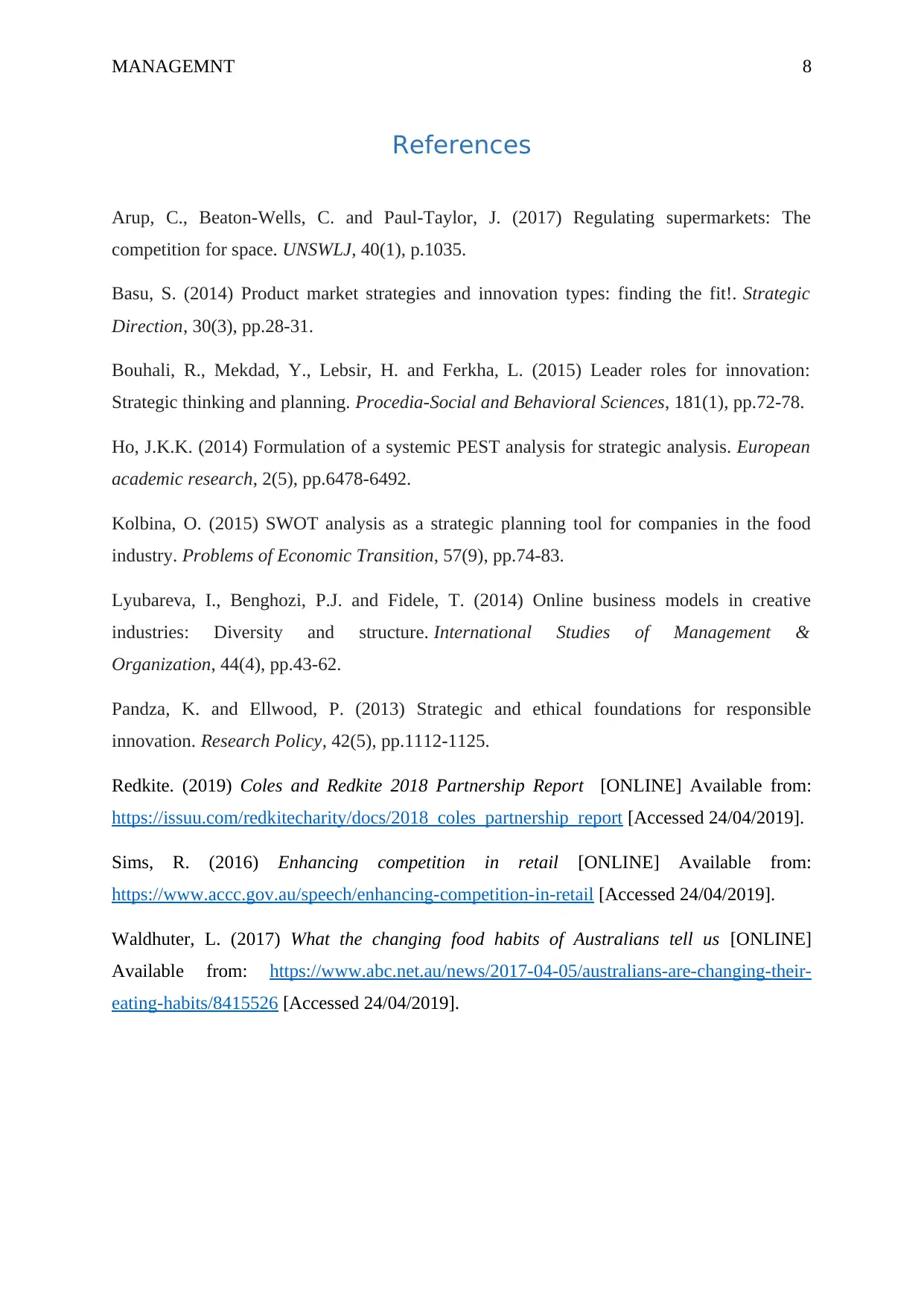
MANAGEMNT 8
References
Arup, C., Beaton-Wells, C. and Paul-Taylor, J. (2017) Regulating supermarkets: The
competition for space. UNSWLJ, 40(1), p.1035.
Basu, S. (2014) Product market strategies and innovation types: finding the fit!. Strategic
Direction, 30(3), pp.28-31.
Bouhali, R., Mekdad, Y., Lebsir, H. and Ferkha, L. (2015) Leader roles for innovation:
Strategic thinking and planning. Procedia-Social and Behavioral Sciences, 181(1), pp.72-78.
Ho, J.K.K. (2014) Formulation of a systemic PEST analysis for strategic analysis. European
academic research, 2(5), pp.6478-6492.
Kolbina, O. (2015) SWOT analysis as a strategic planning tool for companies in the food
industry. Problems of Economic Transition, 57(9), pp.74-83.
Lyubareva, I., Benghozi, P.J. and Fidele, T. (2014) Online business models in creative
industries: Diversity and structure. International Studies of Management &
Organization, 44(4), pp.43-62.
Pandza, K. and Ellwood, P. (2013) Strategic and ethical foundations for responsible
innovation. Research Policy, 42(5), pp.1112-1125.
Redkite. (2019) Coles and Redkite 2018 Partnership Report [ONLINE] Available from:
https://issuu.com/redkitecharity/docs/2018_coles_partnership_report [Accessed 24/04/2019].
Sims, R. (2016) Enhancing competition in retail [ONLINE] Available from:
https://www.accc.gov.au/speech/enhancing-competition-in-retail [Accessed 24/04/2019].
Waldhuter, L. (2017) What the changing food habits of Australians tell us [ONLINE]
Available from: https://www.abc.net.au/news/2017-04-05/australians-are-changing-their-
eating-habits/8415526 [Accessed 24/04/2019].
References
Arup, C., Beaton-Wells, C. and Paul-Taylor, J. (2017) Regulating supermarkets: The
competition for space. UNSWLJ, 40(1), p.1035.
Basu, S. (2014) Product market strategies and innovation types: finding the fit!. Strategic
Direction, 30(3), pp.28-31.
Bouhali, R., Mekdad, Y., Lebsir, H. and Ferkha, L. (2015) Leader roles for innovation:
Strategic thinking and planning. Procedia-Social and Behavioral Sciences, 181(1), pp.72-78.
Ho, J.K.K. (2014) Formulation of a systemic PEST analysis for strategic analysis. European
academic research, 2(5), pp.6478-6492.
Kolbina, O. (2015) SWOT analysis as a strategic planning tool for companies in the food
industry. Problems of Economic Transition, 57(9), pp.74-83.
Lyubareva, I., Benghozi, P.J. and Fidele, T. (2014) Online business models in creative
industries: Diversity and structure. International Studies of Management &
Organization, 44(4), pp.43-62.
Pandza, K. and Ellwood, P. (2013) Strategic and ethical foundations for responsible
innovation. Research Policy, 42(5), pp.1112-1125.
Redkite. (2019) Coles and Redkite 2018 Partnership Report [ONLINE] Available from:
https://issuu.com/redkitecharity/docs/2018_coles_partnership_report [Accessed 24/04/2019].
Sims, R. (2016) Enhancing competition in retail [ONLINE] Available from:
https://www.accc.gov.au/speech/enhancing-competition-in-retail [Accessed 24/04/2019].
Waldhuter, L. (2017) What the changing food habits of Australians tell us [ONLINE]
Available from: https://www.abc.net.au/news/2017-04-05/australians-are-changing-their-
eating-habits/8415526 [Accessed 24/04/2019].
⊘ This is a preview!⊘
Do you want full access?
Subscribe today to unlock all pages.

Trusted by 1+ million students worldwide
1 out of 9
Related Documents
Your All-in-One AI-Powered Toolkit for Academic Success.
+13062052269
info@desklib.com
Available 24*7 on WhatsApp / Email
![[object Object]](/_next/static/media/star-bottom.7253800d.svg)
Unlock your academic potential
Copyright © 2020–2025 A2Z Services. All Rights Reserved. Developed and managed by ZUCOL.





